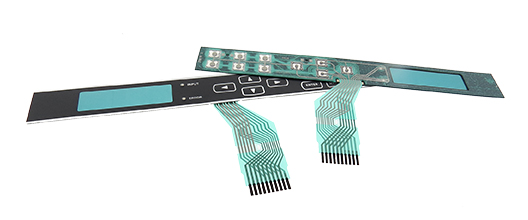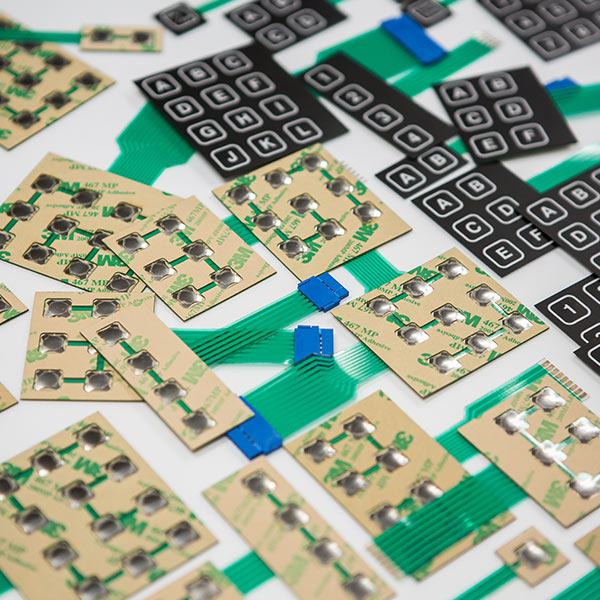Why Membrane Switches Are Preferred for Their Thin and Compact Layouts
Why Membrane Switches Are Preferred for Their Thin and Compact Layouts
Blog Article
Discover the Future of Control Interfaces: Why Membrane Switches Are Getting Popularity
As markets progressively prioritize easy to use and reliable control interfaces, membrane layer buttons are becoming a compelling remedy that integrates capability with design versatility. Their resilience and portable nature make them especially matched for a range of applications, from healthcare to consumer electronic devices. With the surge of smart technology and sustainability issues, the advancements and abilities surrounding membrane layer switches warrant closer examination. What details advantages do they supply that could redefine our communications with modern technology in the coming years?
Comprehending Membrane Switches
Membrane buttons are important components in modern digital devices, functioning as interfaces in between individuals and equipments. These buttons contain multiple layers, commonly consisting of a graphic overlay, a spacer layer, and a circuit layer. When a customer presses a switch on the overlay, the leading layer makes call with the circuit layer, completing a circuit and sending a signal to the device. This straightforward yet effective mechanism permits for seamless communication with technology.

Sturdiness is another essential feature, as membrane layer buttons can be developed to withstand environmental variables such as wetness, dirt, and chemicals. This durability makes them ideal for applications in extreme conditions. In general, comprehending the structure and function of membrane layer switches is essential for valuing their duty in the advancement of individual interfaces in today's technology-driven world.
Trick Advantages of Membrane Layer Switches
Providing an array of advantages, membrane layer switches have actually ended up being a favored option in various applications (Membrane Switches). Among the main advantages is their portable style, allowing producers to optimize space in devices without jeopardizing performance. Membrane layer buttons are lightweight, which is particularly useful in mobile electronic gadgets

In addition, these buttons supply exceptional resilience. Constructed from adaptable products, they are resistant to dirt, moisture, and a range of environmental variables, making them appropriate for extreme conditions. This longevity commonly translates into a longer lifespan contrasted to typical mechanical switches.
In addition, membrane switches over permit smooth integration of signs and graphics, supplying aesthetic versatility and boosting user experience. Personalization options are extensive, enabling brands to create unique interfaces that straighten with their product identification.
The flat surface area of membrane changes stops the accumulation of dirt and crud, making them excellent for sanitary settings. Membrane layer buttons are cost-effective, as they can be generated in high volumes at lower prices, making them easily accessible for a large range of sectors.
Applications Across Industries

A myriad of markets are significantly taking on membrane buttons because of their adaptability and capability. These control user interfaces are particularly widespread in the automotive sector, where they are made use of in dashboards and infomercial systems, providing a sleek and user-friendly interface. In the clinical field, membrane layer changes help with the operation of diagnostic equipment and client monitoring systems, guaranteeing integrity and simplicity of use in critical circumstances.
In addition, the customer electronic devices industry take advantage of membrane layer buttons in tools such as microwaves and push-button controls, enabling streamlined layout and enhanced longevity. Membrane Switches. The aerospace field also utilizes membrane switches in cockpit controls, where area restraints require small and effective style options
Additionally, the commercial market uses membrane buttons in machinery control board, using resilience versus rough atmospheres and guaranteeing operational performance. Retail environments have actually accepted membrane switches in point-of-sale systems, enhancing user interaction while preserving visual appeal.
Design Patterns in Membrane Switches
Developing alongside technical advancements, design patterns in membrane layer buttons are increasingly concentrated on boosting user experience and visual appeal. Modern membrane layer buttons are being designed for simpleness and intuitive usage, permitting customers to browse interfaces easily. This shift in the direction of user-centric design emphasizes tactile comments, ensuring that users obtain prompt verification of their activities.
In addition, personalized graphics and colors are coming to be standard attributes in membrane layer switch layouts. This versatility enables manufacturers to create customized user interfaces that straighten link with branding and specific individual requirements. The incorporation of backlighting is one more prominent pattern, as it not just enhances exposure in low-light conditions but additionally adds an aesthetically striking component to the general design.
Additionally, the pattern towards lightweight and thin materials is gaining grip, enabling sleeker designs that can flawlessly incorporate into numerous applications. This shift not just boosts aesthetics but likewise adds to the overall capability and resilience of the buttons. Environment-friendly products are progressively being utilized, showing a broader activity towards sustainability in item design. These design patterns jointly underscore the expanding value of combining form and feature in the advancement of membrane switches, inevitably enhancing the user experience.
Future Overview for Control Interfaces
The future of control interfaces is positioned for substantial change as arising innovations remain to improve customer communications across various devices. The assimilation of advanced products, such as conductive inks and versatile electronic devices, will enhance the versatility and capability of membrane layer buttons, making them increasingly adaptable to a series of applications. In addition, the surge of the Web of Points (IoT) will certainly drive demand for more intuitive, user-friendly interfaces that can perfectly integrate with smart tools.
As synthetic knowledge and artificial intelligence develop, control interfaces will likely integrate more personalized attributes, allowing individuals to interact with tools in ways that are customized to their routines and choices (Membrane Switches). This change towards user-centric style will place membrane layer buttons as a principal on the market, specifically in markets like healthcare, automobile, and customer electronic devices
Moreover, the promote sustainability will urge suppliers to check out environmentally friendly materials and production approaches, guaranteeing that the future of control user interfaces lines up with environmental considerations. In general, as technology proceeds to development, membrane layer buttons will certainly come to be increasingly sophisticated, leading the method for cutting-edge control services that boost customer experience and functional efficiency throughout diverse markets.
Final Thought
To conclude, the increasing fostering of membrane layer switches over highlights their significance in the advancement of control interfaces. Their small layout, toughness, and personalization choices line up with the demands of modern-day innovation throughout various sectors. As user-friendly interfaces come to be essential in the context of IoT and AI innovations, membrane buttons are positioned to play a vital role. The ongoing trends in the direction of sustainability additionally improve their click this charm, guaranteeing that membrane layer buttons will certainly continue to be indispensable to future technological innovations.
As industries increasingly focus on efficient and straightforward control interfaces, membrane layer switches are arising as an engaging service that incorporates performance with style flexibility.Toughness is another essential function, as membrane switches can be developed to resist ecological factors such as dampness, dirt, and chemicals.Developing Find Out More alongside technical improvements, style fads in membrane buttons are increasingly concentrated on boosting customer experience and aesthetic appeal. Modern membrane layer switches are being developed for simpleness and user-friendly usage, permitting users to navigate interfaces effortlessly. These layout trends jointly underscore the expanding importance of integrating form and function in the growth of membrane layer buttons, inevitably improving the customer experience.
Report this page